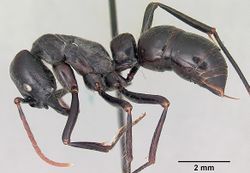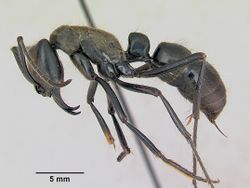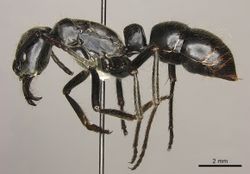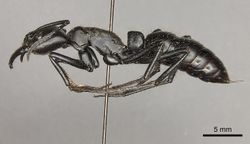Key to Dinoponera workers
Key to workers of Dinoponera based on Dias & Lattke (2021). Got males? See the key to Dinoponera males.
1
- Integument mostly smooth and shining; microsculpturing not visible on first gastric tergite (best seen at 32 × magnification) (fig. 3A) => 2
- Integument mostly microareolate and opaque; microsculpturing always visible on first gastric tergite (best seen at 32 × magnification) (fig. 3B) => 6
2
return to couplet #1
- Petiolar node in lateral view with the anterodorsal angle at a level clearly lower than the posterodorsal angle (fig. 4A). Anteroventral corner of pronotum in lateral view with a tooth or forming an acute angle => Dinoponera lucida (east of Brazil)
- Petiolar node in lateral view with the anterodorsal angle higher, at the same level as or slightly lower than the posterodorsal angle (fig. 4B). Anteroventral corner of pronotum in lateral view without a tooth, forming obtuse angle at most => 3
3
return to couplet #2
- Body covered by thick and stiff hairs (fig. 5A). Ventral surface of head posteriorly with wellmarked transverse strigulae posteriorly => Dinoponera hispida (Brazil: Pará)
- Body covered by slender and flexuous hairs (fig. 5B). Ventral surface of head posteriorly without strigulae; if strigulae present, only anterolaterally => 4
4
return to couplet #3
- Petiolar node in lateral view with its anterodorsal angle at a level clearly higher than the posterodorsal angle (fig. 6A) => Dinoponera longipes (northwest of Brazil, Colombia and Peru)
- Petiolar node in lateral view with its anterodorsal angle slightly lower or at approximately the same level as the posterodorsal angle (fig. 6B) => 5
5
return to couplet #4
- Dorsal margin of petiolar node in lateral view convex (fig. 7A). Golden pilosity present on frons and first gastric tergite. first gastric tergite with sparse pubescence on entire surface => Dinoponera nicinha (northwest of Brazil)
- Dorsal margin of petiolar node in lateral view straight (fig. 7B). Chestnut pilosity present on frons and first gastric tergite. first gastric tergite with dense pubescence laterally => Dinoponera mutica (northwest and midwest of Brazil, Bolivia and Paraguay)
6
return to couplet #1
- Malar area with striae that reach entire anterior eye margin (fig. 8A); hind basitarsus less than 6 mm long => Dinoponera grandis (Argentina, Bolivia, Brazil and Paraguay)
- Malar area without striae or with weak striae that do not reach entire anterior eye margin (fig. 8B); hind basitarsus usually more than 6 mm long => 7
7
return to couplet #7
- Anteroventral corner of pronotum in lateral view without tooth, at most forming an obtuse angle (fig. 9A). Ventral surface of head without striae => Dinoponera quadriceps (northeast of Brazil)
- Anteroventral corner of pronotum in lateral view with tooth or forming acute angle (fig. 9B). Ventral surface of head with striae at least on the anterior half => Dinoponera gigantea (north of Brazil, Colombia and Peru)



















